Exhibitions
Hokusai and Hiroshige―The Thirty-six Views of Mt. Fuji and the Fifty-three Stages of the Tōkaidō
2018.03.16(Fri) - 2018.04.24(Tue)

Overview
◆ Thirty-Six Views of Mount Fuji by Katsushika Hokusai
A series of woodblock prints Thirty-Six Views of Mount Fuji was first published in 1831 by Nishimura Eijudō press, bringing fame to its creator Katsushika Hokusai (1760-1849). It is generally considered that 36 designs were published initially, with 10 additional designs that followed later. The series is thus complete with the total of 46 pictures. The first 36 depict Mount Fuji from the Pacific coast side while the later 10 capture the mountain from “behind,” known as Ura-Fuji.
Backed by the popular movement of his time to worship the revered mountain, this series of prints enjoyed an immense success for the extraordinary compositions and striking color rendering, using rare imported pigments such as Berlin Blue. One of the most notable aspects is that many paintings contain lively depiction of common people at work or leisure. Bold and radical compositions and free-spirited arrangements are also distinctive. It is naturally considered to be the masterpiece, epitomizing the colossal body of Hokusai’s artistic endeavor.
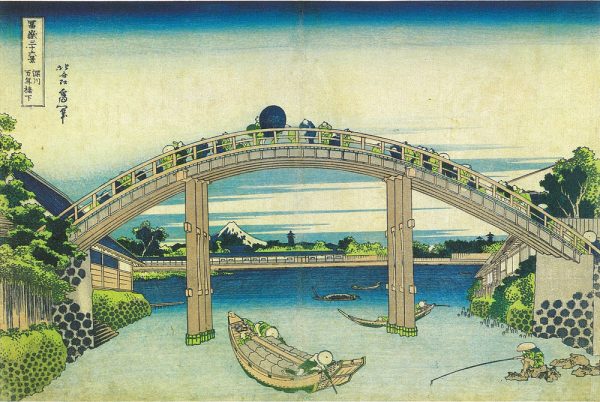
Thirty-six Views of Mt. Fuji UNDER MANNEN-BASHI BRIDGE AT FUKAGAWA
The print shows an arched bridge, Mannen-bashi, spanning over Onagi River, a tributary of Sumida River, seen from the upstream and Mt. Fuji in the distance. Rows of houses on both banks of the river are depicted in perspective and with an exaggerated touch typical to Hokusai.
There are 18 designs illustrating scenes of Edo downtown and its suburbia. Each of them selects certain types of people and scenes of animate town-life, through which viewers see Mount Fuji in the background. For example, the roofers in Surugacho in Edo and the farmers in A Waterwheel at Onden both paint the working personage set against Mount Fuji, and similarly Hokusai depict fishermen and woodcutter in Kajikazawa in Kai Province and In the Mountains of Totoumi Province, expressing the artist’s deep empathy with people engaging in work. Hokusai spent years drawing illustrations and creating art manuals, through which he developed his own style and dexterity in depicting personage. Many examples are found in his volumes of humorous illustrations, Hokusai Manga.
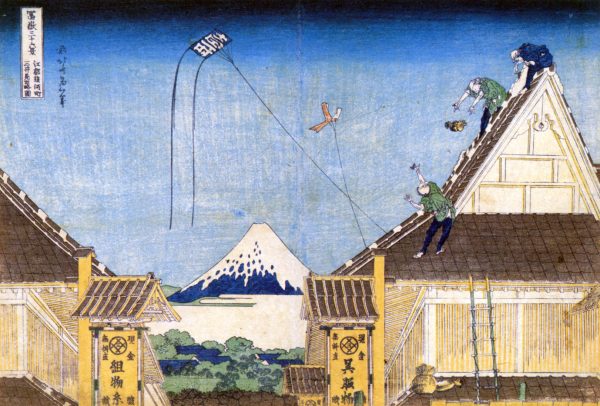
Thirty-six Views of Mt. Fuji SURUGACHŌ IN EDO
Mitsui’s Kimono Store ( Echigoya ), the precursor to the present day Mitsukoshi department store, was located at Muromachi in Nihonbashi and was very popular. The print shows signboards reading “fabrics for kimono”, “braids and threads”, “cash, no down payments” posted in front of Echigoya. From a higher vantage point, Hokusai vividly depicted workers mending roofs and Mt. Fuji in the background.
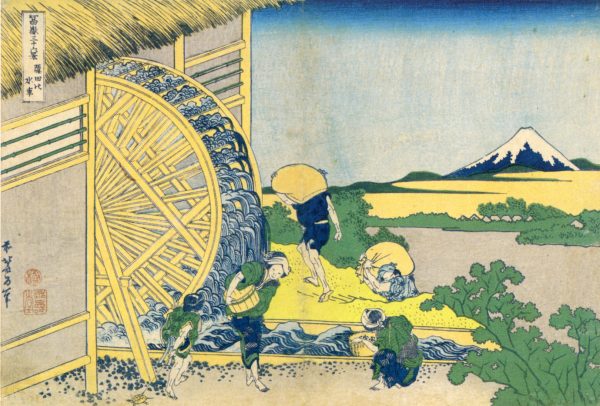
Thirty-six Views of Mt. Fuji A WATERWHEEL AT ONDEN
Onden ( Harajuku and Aoyama ) was tranquil fields where waterwheels spun along Shibuya River. It was one of Edo’s sightseeing spots. The scene shows a large waterwheel, a distant Mt. Fuji above hazy clouds, crop handlers, women washing rice and Hokusai’s marked style of the water.
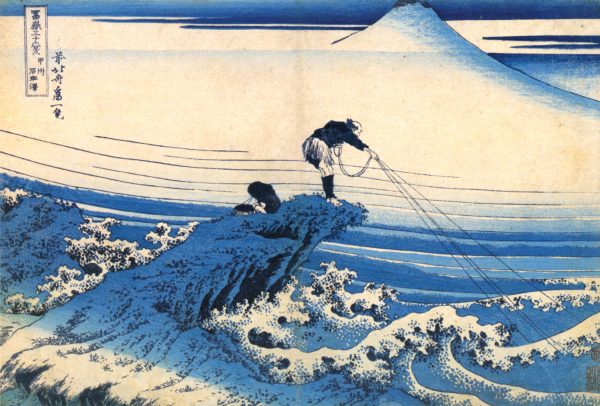
Thirty-six Views of Mt. Fuji KAJIKAZAWA IN KAI PROVINCE
Fuefuki River and Kamanashi River converge at Kajikazawa ( Yamanashi prefecture ) and become Fuji River, which is one of Japan’s three rapid currents. The print deftly expresses the furious river as if it were a roaring sea, a fisherman casting a net and a child squatting at his feet. In reality, Mt. Fuji cannot be seen from Kajikazawa and in this work is sketched only by its outline.
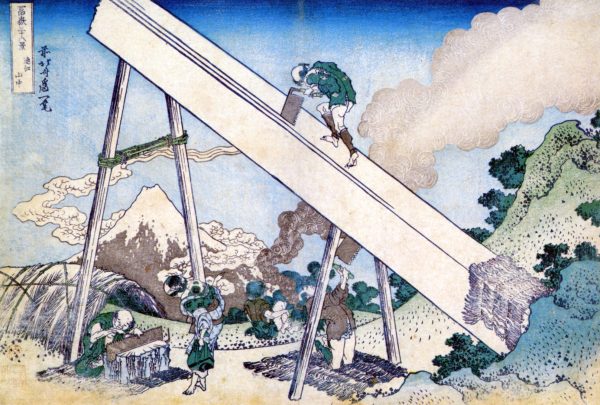
Thirty-six Views of Mt. Fuji IN THE MOUNTAINS OF TŌTOUMI PROVINCE
The scene was probably sketched in the deep mountains where the tributaries of Tenryū and Ōi Rivers originated. It depicts a woodman in the center working on a wooden block diagonally placed in the picture and his family working in the mountains. Such use of the diagonal reflects Hokusai’s typical artistic form.
Another remarkable aspect of this work is the mastery of Hokusaiesque compositions and arrangements so bold and spontaneous. He places the iconic mountain inside a round frame of a pail-in-making, or with a parallel triangle of a temple in Asakusa. In Ushibori in Hitachi Province, he places Fuji in one corner with a dramatic layout of a boat dividing the canvas diagonally in two. The scene of Hodogaya on the Tōkaidō Highway is striking with the vertical lines of pine trees uniquely framing Mount Fuji. Others are equally impressive: South Wind, Clear Sky expresses the artist’s sensitive affinity with nature, The Great Wave off Kanagawa gives a glimpse of the mountain through the howling waves, and The Mannenbashi Bridge on Fukagawa River emphasizes the curious structural form of the bridge. We can witness through these how Hokusai developed his ideas for new compositions.
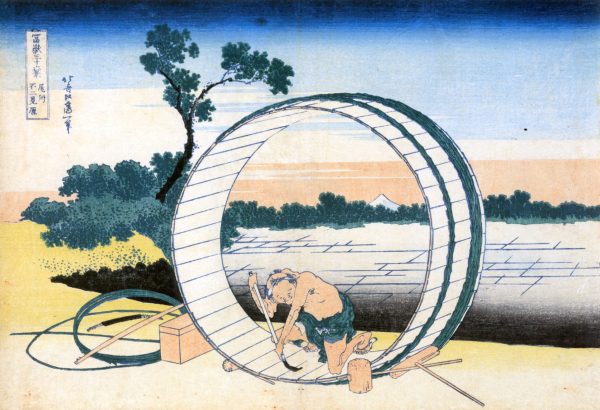
Thirty-six Views of Mt. Fuji FUJIMIGAHARA IN OWARI PROVINCE
It is believed that this is a scene from present day Fujimichō, Naka-ku in Nagoya City, the western boundary for observing Mt. Fuji. The geometrical combination of a miniature triangular Mt. Fuji viewed through a large round frame of a tub is the product of Hokusai’s originality. The humorous expression of the barrel maker is characteristic of Hokusai’s portrait style which also appears in his third collection of Hokusai Manga.
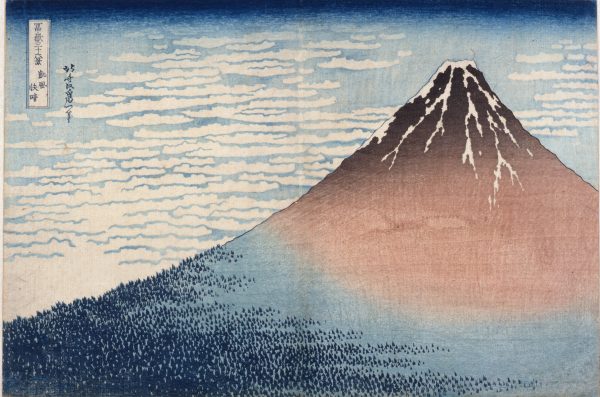
Thirty-six Views of Mt. Fuji A MILD BREEZE ON A FINE DAY
This is the most striking masterpiece among Hokusai’s Thirty-six Views of Mt. Fuji. More commonly known as “The Red Fuji”, it expresses the lasting grandeur and vigor of this famous mountain by the simple tricolors of indigo, green and reddish brown. The scene shows Mt. Fuji in the early morning on a fine day with a mild breeze in the air.
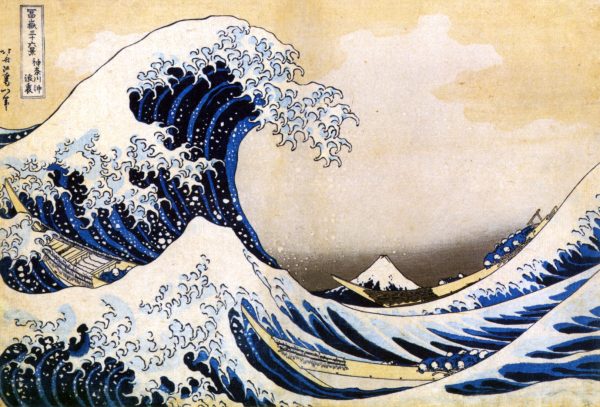
Thirty-six Views of Mt. Fuji THE GREAT WAVE OFF KANAGAWA
This masterpiece made Hokusai famous as the “painter of waves”. The sea is roaring and the rolling waves are about to collapse any moment. Fishing boats trapped inside the waves are desperately trying to stay balanced. Mt. Fuji appearing behind the rough waves remains calm. Only Hokusai could have come up with a picture expressing nature’s energy versus man power, stillness versus dynamism in such a unique and forceful composition.
◆ Katsushika Hokusai the artist
Hokusai was born in 1760 in the eastern district of Edo, Honjo. Having learned wood carving at a young age, he started out as an apprentice under Katsukawa Shunshō and busied himself drawing theatrical stars. He was expelled when he was found out to have been studying the Kanō style painting under Kanō Yūsen. He then explored various schools: Tosa school with Sumiyoshi Naiki and Rinpa school with Tsutsumi Tōrin. Finally, he came to master the school of Tawaraya Sōri, and he succeeded him as Tawaraya Sōri II. His quest for new frontiers of artistic expressions continued, extending his interest to Chinese and European paintings. He changed his pseudonym as he progressed in his accomplishments, counting more than 30 including Hokusai, Taito, Iitsu and Manji. His repertoire was extensive, covering brush paintings, book illustrations and humorous drawings, with motifs spanning from actors and elegant women to natural subjects and landscapes. He was a born painter until the end of his 90-year-long life – as his latter-day pseudonym suggests: Gakyō Rōjin meaning an old man mad about art. His unceasing desire to capture all that have forms was paramount, and he dedicated his life to a never-ending quest for perfection.
◆ Hiroshige’s Fifty-three Stations of the Tōkaidō (the Hōeidō edition)
Utagawa Hiroshige (1797-1858), aged 36, joined the entourage of Shogun’s expedition of 1832 for presenting horses to the Emperor and traveled from Edo to Kyoto. On his return, Hiroshige created a set of 55 paintings and published them from Hōeidō press the following year. As this small press could not handle all the paintings by themselves, the work was partially outsourced to another printing company Senkakudō (owned by Tsuruya Kiemon), which either helped with certain woodblocks or published some paintings independently. Thus came about the Fifty-three Stations of the Tōkaidō. A great success of the series made Hōeidō a reputable press, and Hiroshige became the most famous landscape ukiyo-e artist.
One of the characteristics of this series is the realistic rendition of the scenes – the community at each station as well as the views along the route, with detailed depiction of local customs and fellow travelers. Though realistic in composition, some pictures do not correspond to existing landscapes, such as the famous views of Hakone, Kanbara and Shono. Also, the landscapes of Yoshida and Narumi may have been composed based on the impression he had as he walked passing these locations.
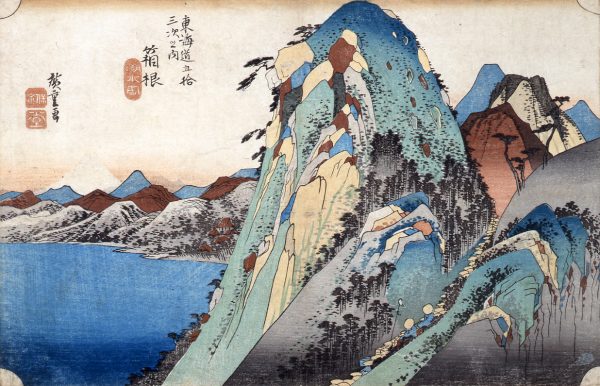
From the Fifty-three Stages on the Tōkaidō, HAKONE
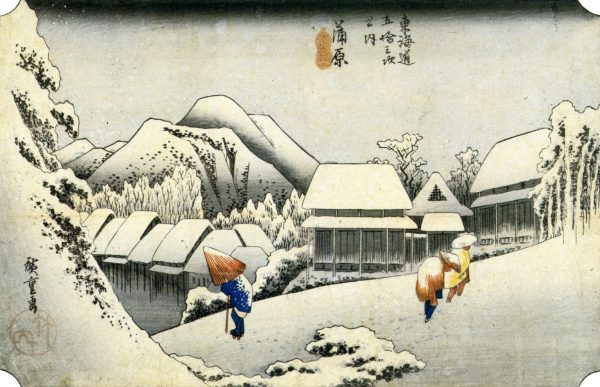
From the Fifty-three Stages on the Tōkaidō KAMBARA: SCENE OF A SNOWY NIGHT
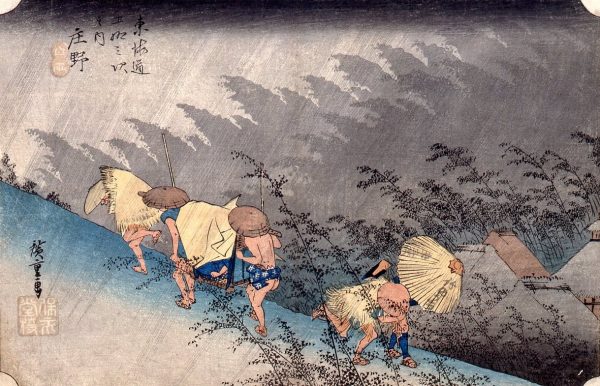
From the Fifty-three Stages on the Tōkaidō SHŌNO: SHOWER
Another notable aspect of this collection is the sense of seasonal changes and rich emotions of the travelers. Kanbara and Kameyama under snow, rainfalls in Oiso, Shono and Tsuchiyama, and winds of various types seen in Kakegawa and Yokkaichi... Variations also extends to the times of the day, effectively incorporated into the canvas: early morning in Nihonbashi, Mishima, Hara and Mitsuke, and evening in Numazu, Goyu and Ishiyakushi, then nightscapes of Kanbara and Miya. As dexterous as he was, Hiroshige made effective use of these elements - seasonal, meteorological and temporal variations - together with fine depictions of customs and people observed along the expressway. The paintings would stimulate townspeople’s curiosity for traveling. The poetic landscape painting that appealed to the Japanese sentimentalism eventually crossed the oceans and influenced art scenes as far as in Europe.
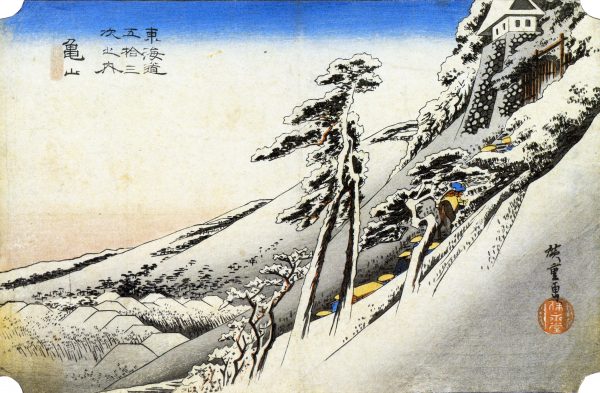 From the Fifty-three Stages on the Tōkaidō KAMEYAMA
From the Fifty-three Stages on the Tōkaidō KAMEYAMA
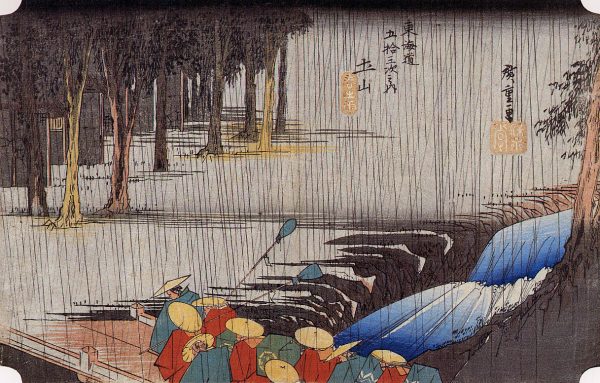 From the Fifty-three Stages on the Tōkaidō TSUCHIYAMA: SPRING RAIN
From the Fifty-three Stages on the Tōkaidō TSUCHIYAMA: SPRING RAIN
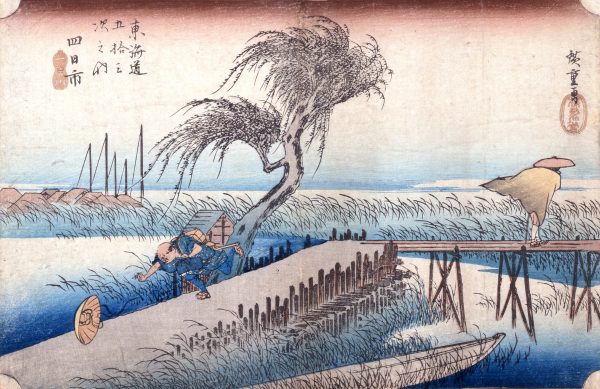 From the Fifty-three Stages on the Tōkaidō YOKKAICHI: MIE RIVER
From the Fifty-three Stages on the Tōkaidō YOKKAICHI: MIE RIVER
◆ The Tōkaidō route - travelers of Edo period
Immediately after the victory of the Battle of Sekigahara in 1601, the Shogun Tokugawa Ieyasu embarked on the development of major traveling routes with stations. Starting with the Tōkaidō route, the Shogunate laid Nakasendō, Nikkōdō, Oshūdōchū and Kōshūdōchū over the following years. As a route that connected Edo to the Imperial court of Kyoto, the Tōkaidō was considered the most significant of them.
In the early 17th century, the Tōkaidō route was mainly used by Shogunate officials traveling to Kyoto, Daimyo expeditions from their domains to Edo, and diplomat parties from the continent. The stations gradually developed larger and better, and the people along the route prospered from selling merchandise to travelers. The route facilitated a traffic of goods and culture.
In the mid-18th century, travels became a popular preoccupation of better-off commoners. Stations housed inns for these travelers known as a hatagoya, and tourism emerged in the areas of historical interest along the route.
The rise of tourism stimulated many publications including route maps, local guides, travel memoirs and stories. Notably, a satirical comic novel by Jippensha Ikku “Tōkaidōchū Hizakurige” (known in translation as Shank’s Mare) was a phenomenal success. In the early 19th century, traveling was never more popular. People in Edo frequented nearby destinations such as Narita, Oyama and Enoshima. Those who opted for farther afield would dream about making once-in-a-lifetime journey to Ise the Grand Shine or the Kompira Temple on Shikoku island.
The Tōkaidō route spanned nearly 490 kilometers from Nihonbashi in Edo to Kyoto, with 53 stations along the way. Two border control points were also erected, one in Hakone and the other in Arai. The trek was not easy as the route presented many challenging paths as well; steep peaks and wide rivers to walk across, and a ferry to cross over the channel of Ise bay. Travelers of this period typically started at around 4 o’clock in the morning, and the average mileage for males was about 40 kilometers a day. Thus, people took 10 to 14 days to walk from Tokyo to Kyoto. The courier of the time, carrying official mails, would run across the route in three days.
The entire sets of 46 prints from the Thirty-Six Views of Mount Fuji and 55 from the Fifty-three Stations of the Tōkaidō – together, this is an indulgent opportunity to admire the masterpieces of the two iconic ukiyo-e artists to heart’s content.
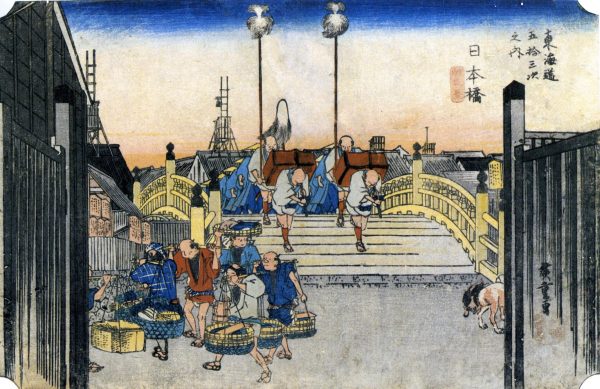 東海道五十三次 日本橋
東海道五十三次 日本橋
日本橋は京都まで120余里(およそ490km)、東海道五十三次の起点である。橋の手前5~6人の魚屋が早朝の肴市から買い求めた魚をかつぎ、橋の上を大名行列の先頭が渡って来る。あわただしい朝の日本橋界隈の情景が描かれている。
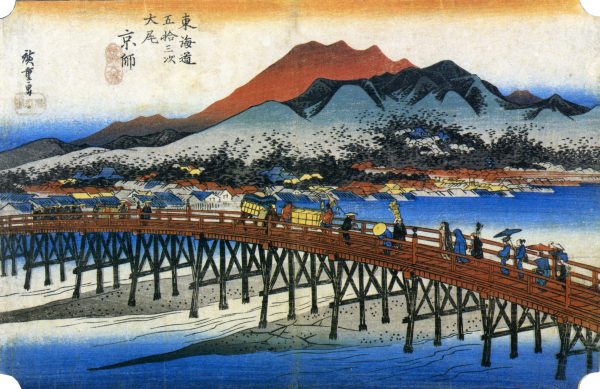
東海道五十三次 京師
加茂川にかかる三条大橋を渡れば京都である。当時、江戸・京都間を普通に歩けば十数日の行程であった。図は、三条大橋を八朔御馬献上の行列が渡っている様子で、遠くには東山三十六峰と比叡山が描かれている。
